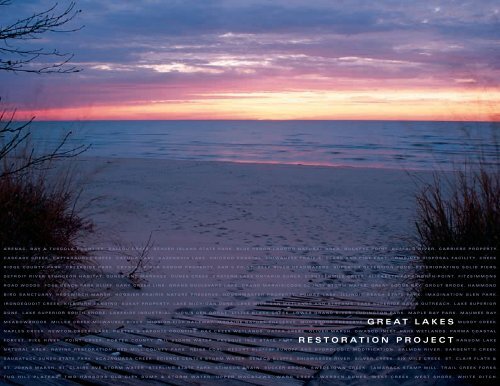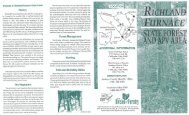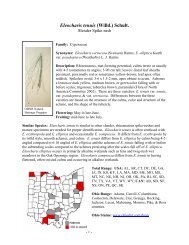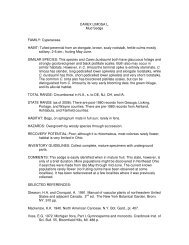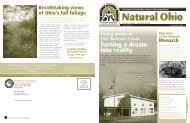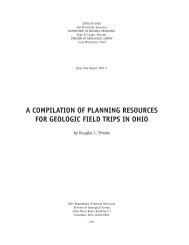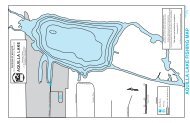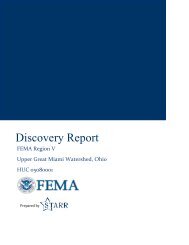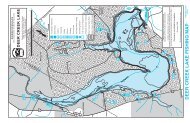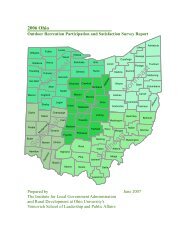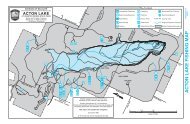Great Lakes Restoration Project - Ohio Department of Natural ...
Great Lakes Restoration Project - Ohio Department of Natural ...
Great Lakes Restoration Project - Ohio Department of Natural ...
- No tags were found...
You also want an ePaper? Increase the reach of your titles
YUMPU automatically turns print PDFs into web optimized ePapers that Google loves.
ARENAC, BAY & TUSCOLA COUNTIES. BALLOU CREEK. BEAVER ISLAND STATE PARK. BLUE HERON LAGOON NATURAL AREA. BUCKEYE POINT. BUFFALO RIVER. CARRIERE PROPERTY.CASCADE CREEK. CATTARAUGUS CREEK. CAYUGA LAKE. CAZENOVIA LAKE. CHICAGO COASTAL. CHIWAUKEE PRAIRIE. CLARK AND PINE EAST. COMBINED DISPOSAL FACILITY. CREEKRIDGE COUNTY PARK. CREEKSIDE PARK. CRYSTAL RIVER OXBOW PROPERTY. DAN’S POINT. DEEP RIVER HEADWATERS. SUPERIOR DETENTION POND. DETERIORATING SOLID PIERS.DETROIT RIVER STURGEON HABITAT. DUNES AND MARSHES. DUNES CREEK. EASTERN LAKE ONTARIO DUNES. EIGHTEENMILE CREEK. ELIZABETH PARK NORTH POINT. FITZSIMMONSROAD WOODS. FOSS BEACH PARK BLUFF. GARY GREEN LINK. GRAND BOULEVARD LAKE. GRAND MARAIS/COOK COUNTY STORM WATER. GREAT SODUS BAY. GROUT BROOK. HAMMONDBIRD SANCTUARY. HEGEWISCH MARSH. HOOSIER PRAIRIE NATURE PRESERVE. HOUGHMASTER PROPERTY. HUIRAS LAKE. ILLINOIS BEACH STATE PARK. IMAGINATION GLEN PARK.IRONDEQUOIT CREEK. KILBOURN LANDING. KUKAY PROPERTY. LAKE MICHIGAN DUNE. LAKE MICHIGAN WETLANDS AND STREAMS. LAKE SUPERIOR BASIN OUTREACH. LAKE SUPERIORDUNE. LAKE SUPERIOR SOUTH SHORE. LAKESIDE INDUSTRIAL. LION’S DEN GORGE. LITTLE BLACK CREEK. LOWER GRAND RIVER. LUDINGTON PARK. MAPLE BAY PARK. MAUMEE BAY.MEADOWBROOK. MILLER CREEK MILWAUKEE RIVER. MISSION FISH RACEWAY. MORAINE NATURE PRESERVE. MUD BROOK PRESERVE. GREAT LAKESMUDDY CREEK.NAPLES CREEK. NEWTON CREEK. LAKE, PORTER & LAPORTE COUNTIES. OAK CREEK WETLANDS. OATKA CREEK. OLIVER MARSH. OWASCO INLET. PARK WETLANDS. PARMA COASTALFOREST. PIKE RIVER. POINT CREEK. PORTER COUNTY JAIL STORM WATER. PRESQUE ISLE STATE PARK. RESTORATIONPROJECTRANSOM LAKENATURAL AREA. RAVINE RESTORATION. RED MILL COUNTY PARK. REISS COAL. RESORT BLUFFS. RUNOFF AND HYDROLOGIC MODIFICATION. SALMON RIVER. SARGENT’S CREEK.SAUGATUCK DUNES STATE PARK. SCAJAQUADA CREEK. SCIENCE CENTER STORM WATER. SENECA BLUFFS. SHIAWASSEE RIVER. SILVER CREEK. SIX MILE CREEK. ST. CLAIR FLATS &ST. JOHNS MARSH. ST. CLAIRE AVE STORM WATER. STERLING STATE PARK. STIMSON DRAIN. SUCKER BROOK. SWEDETOWN CREEK. TAMARACK STAMP MILL. TRAIL CREEK FORKS.TUG HILL PLATEAU. TWO HARBORS OLD CITY DUMP & STORM WATER. UPPER MACATAWA. WARD CREEK. WARREN DUNES. WEST CREEK. WEST SHORE. WHITE DITCH.
ContentsIllinois <strong>Great</strong> <strong>Lakes</strong><strong>Restoration</strong>s 2-3ProtectingIndiana’s CoastalResources 4-5<strong>Great</strong> <strong>Lakes</strong> <strong>Restoration</strong> <strong>Project</strong>A Progress Report to Congress by the <strong>Great</strong> <strong>Lakes</strong> StatesAcquisitions and<strong>Restoration</strong>s to BenefitMichigan’s CoastalResources 6-7Restoring Minnesota’sLake SuperiorCoast 8-9Protecting andRestoring New York’s<strong>Great</strong> <strong>Lakes</strong> 10-11<strong>Great</strong> <strong>Lakes</strong>Coastal <strong>Restoration</strong>in <strong>Ohio</strong> 12-13Pennsylvania’sGateway to the<strong>Great</strong> <strong>Lakes</strong> 14-15<strong>Great</strong> <strong>Restoration</strong>son Wisconsin’s<strong>Great</strong> <strong>Lakes</strong> 16-17Letter from the <strong>Great</strong><strong>Lakes</strong> Commission 18Letter fromthe Coastal StatesOrganization 19Directory <strong>of</strong><strong>Great</strong> <strong>Lakes</strong> <strong>Restoration</strong>Agencies 20ILLINOIS | INDIANA | MICHIGAN | MINNESOTA | NEW YORK | OHIO | PENNSYLVANIA | WISCONSINMARCH 2003
<strong>Great</strong> <strong>Lakes</strong>Thank You, Congress!America’s <strong>Great</strong> <strong>Lakes</strong> are more than waterbodies.They are a vast, complex system <strong>of</strong>inland seas that provide fresh water tomillions, access to world markets and diverserecreation for residents and visitors alike.In 2001, Congress appropriated $30 million toacquire and restore critical habitat, implementstorm water controls and clean contaminatedsites along <strong>Lakes</strong> Erie, Huron, Michigan, Ontarioand Superior.Thus began an unprecedentedpartnership between the federal government andthe eight <strong>Great</strong> Lake states to restore andclean the world’s largest fresh water resource.The federal commitment required states toprovide match at a rate <strong>of</strong> 25%. Instead, the<strong>Great</strong> Lake region has thus far committed $42million <strong>of</strong> state and local match – at a rate <strong>of</strong>58% – to produce $72 million <strong>of</strong> restorationwork along the <strong>Lakes</strong> and their tributaries.Federal State/LocalState Allocation Match TotalIllinois $1,750,000 $3,100,825 $4,850,825Indiana 1,750,000 591,875 2,341,875Michigan 7,000,000 16,646,000 23,646,000Minnesota 1,938,000 1,054,000 2,992,000New York 4,727,000 10,592,000 15,319,000<strong>Ohio</strong> 4,489,000 1,686,000 6,175,000Pennsylvania 1,846,000 1,582,000 3,428,000Wisconsin 5,686,000 6,962,000 12,648,000Other (fed.) 814,000$30,000,000 $42,214,700 $72,214,700The projects supported by this partnershipare so significant – and the need to restore the<strong>Great</strong> <strong>Lakes</strong> is so pr<strong>of</strong>ound – that this is thefirst time the eight <strong>Great</strong> <strong>Lakes</strong> coastalprograms have come together to report on asingle issue.Together with our local partners,we are creating a cleaner, more sustainable<strong>Great</strong> <strong>Lakes</strong> region.However, more work is needed along thecoasts <strong>of</strong> our <strong>Great</strong> <strong>Lakes</strong>!State and community response to the 2001federal appropriation was overwhelming ascoastal managers proposed more qualityprojects than could be funded. Now is thetime to build on our momentum and supportnew <strong>Great</strong> <strong>Lakes</strong>’ restoration efforts.Thankyou, Congress, for recognizing the importance<strong>of</strong> the <strong>Great</strong> <strong>Lakes</strong> and providing criticallyneeded resources for their restoration.GREAT LAKES RESTORATION PROJECT [1]
Illinois <strong>Great</strong> <strong>Lakes</strong> <strong>Restoration</strong>sImproving Illinois’ Public ShorelineThanks to the legacy <strong>of</strong> open space advocates like Montgomery Wardand Daniel Burnham who called for Illinois’ lakefront to remain open,clear and free, today more than 50% <strong>of</strong> the state’s sixty miles <strong>of</strong> LakeMichigan shoreline is in public ownership.This legacy enables millions<strong>of</strong> our residents and national and international visitors to enjoy the manyrecreational opportunities that living along the <strong>Great</strong> <strong>Lakes</strong> provides.It also creates tremendous pressure – in terms <strong>of</strong> overcrowding andstress on both terrestrial and aquatic habitats – which demand constantattention and commitment <strong>of</strong> limited state resources.Restore and Protect the Lake Michigan Coast.The provision <strong>of</strong> <strong>Great</strong> <strong>Lakes</strong> Coastal <strong>Restoration</strong> Grants is making adifference along the Illinois shoreline, providing the incentive toundertake a variety <strong>of</strong> projects to preserve, restore, create and maintainunique coastal habitats.While the funded projects are diverse, they allshare a common objective to restore and protect our coastal areas forfuture generations.In Illinois, Coastal <strong>Restoration</strong> funds are being used in a variety <strong>of</strong>ways including acquisition <strong>of</strong> valuable property in an area undergoingtransformation from industrial to open space, the restoration <strong>of</strong> nativevegetation in Illinois’ only coastal state park, reduction <strong>of</strong> contaminatedrun<strong>of</strong>f, the protection <strong>of</strong> a shoreline area containing wetlands and therestoration <strong>of</strong> a dune area adjacent to a public beach.A common thread running through all the projects is a desire toprovide additional recreational and educational opportunities that willshowcase the benefits – both tangible and intangible – <strong>of</strong> a healthycoastal area.Only a Start. The projects funded with the first <strong>Great</strong> <strong>Lakes</strong>Coastal <strong>Restoration</strong> Grants are only a start. Much remains to bedone.The State <strong>of</strong> Illinois – and our local units <strong>of</strong> government alongthe shoreline – support continuing the good work that this programhas initiated.[ 2] GREAT LAKES RESTORATION PROJECT
<strong>Project</strong> name.Grantee.Grant amount/total project cost.Brief description.Cook CountyHegewisch Marsh.City <strong>of</strong> Chicago.$651,840/$3,500,000.Acquire 100 acres <strong>of</strong> wetlandsand natural areas to preserveand place into public ownershipone <strong>of</strong> the most importantcoastal wetland bird habitats <strong>of</strong>the region.Chicago Coastal <strong>Restoration</strong>.Chicago Park District.$192,000/$240,000.Create a natural dune areaadjacent to a public beach andprovide habitat for rare coastalplant species and the five millionmigratory birds that pass throughChicago each year.Illinois <strong>Great</strong> <strong>Lakes</strong> <strong>Restoration</strong> <strong>Project</strong>sLake County<strong>Lakes</strong>ide Industrial Cleanup.City <strong>of</strong> Zion.$207,200/$259,000.Return an old industrial site togreenfield status.<strong>Restoration</strong> <strong>of</strong> CoastalTerrestrial & WetlandEcosystems at Illinois BeachState Park.Illinois <strong>Department</strong> <strong>of</strong> <strong>Natural</strong>Resources.$45,900/$57,375.Restore plant and animal speciesdiversity and the health <strong>of</strong> nativeplant communities on 90 acres <strong>of</strong>parkland through the reduction <strong>of</strong>exotic and invasive brush.Habitats will be improved for thefederally endangered whiteprairie-fringed orchid and theKamer Blue Butterfly.Coastal Interpretation atIllinois Beach State Park.Illinois <strong>Department</strong> <strong>of</strong> <strong>Natural</strong>Resources.$32,000/$40,000.Construct a visitor friendlyinteractive display <strong>of</strong> LakeMichigan in the lobby <strong>of</strong> the newpark <strong>of</strong>fice that will educatevisitors on the unique ecology <strong>of</strong>this coastal area.Ravine <strong>Restoration</strong>.City <strong>of</strong> Lake Forest.$382,560/$478,200.Develop a ravine storm watermanagement system that willreduce pollution in LakeMichigan and restore naturalravine hydrology.Foss Beach Park Bluff<strong>Restoration</strong>.North Chicago, Foss ParkDistrict.$151,000/$188,750.Emergency bluff restoration toprovide protection to a recentlyrestored wetland and dune areaby using a combination <strong>of</strong> nativevegetation and stone revetment.GREAT LAKES RESTORATION PROJECT [ 3]
Protecting Indiana’s Coastal ResourcesRestoring Indiana’s fragile Lake Michigan coastal resourcesIndiana’s Lake Michigan coastal region supports an amazing array <strong>of</strong>plants and animals and provides recreational retreats for more than twomillion visitors annually.The coastal region is a mixture <strong>of</strong> sand dunes,rivers and streams, forests, wetlands, cities and towns, industry andagriculture. All have an impact on the health <strong>of</strong> Lake Michigan.Hoosiers recognize the importance <strong>of</strong> this <strong>Great</strong> Lake and are takingsignificant steps to restore and protect threatened coastal resources. InIndiana, the congressional appropriation <strong>of</strong> $1.75 million through the<strong>Great</strong> <strong>Lakes</strong> <strong>Restoration</strong> Grants Program leveraged eighteen state andlocal projects that together contributed an additional $560,000 toprotect and restore coastal resources.Native Habitat <strong>Restoration</strong>. Indiana’s coastal regionsupports many rare and endangered natural communities, includingdune and swale, fens, savannas, and prairies.The degradation <strong>of</strong> thesenatural communities affects the ecological health <strong>of</strong> the region.Plant and animal diversity, a critical component <strong>of</strong> Indiana’s coastalecosystem, is threatened by invasive species that crowd out native plantsand animals.<strong>Great</strong> <strong>Lakes</strong> <strong>Restoration</strong> grants will assist in the acquisition <strong>of</strong> over 100acres <strong>of</strong> quality stream and forest habitat.These new parks will buffer astream important for migrating salmon, protect key areas adjacent to anature preserve and establish a new greenway park for a coastal town.Water Quality Improvements. Water quality is one <strong>of</strong>the most important issues facing Northwest Indiana. Lake Michigan isvalued as a drinking and recreational water resource. Although pointsource pollution continues to be reduced, non-point source pollutionis still a challenge. Improving the quality <strong>of</strong> Lake Michigan starts withmaking improvements in the watershed.The <strong>Great</strong> <strong>Lakes</strong> <strong>Restoration</strong> Program will make possible several waterquality improvement projects in Indiana.These projects will preventbacterial contamination at a public beach, reduce excess sediment in aLake Michigan tributary stream, plan for resource management andpublic access, improve fish and wildlife habitat and manage storm waterrun<strong>of</strong>f through best management practices.Indiana <strong>Great</strong> <strong>Lakes</strong> <strong>Restoration</strong> grants will restore approximately 400acres <strong>of</strong> native habitat.These restoration projects will eliminate invasivespecies, re-establish native plant species and implement resourcemanagement principles – such as prescribed burning – that will havesignificant long-term benefits to the Lake Michigan region.Resource and Greenway Protection. Land is valuablein Indiana’s coastal region. Rural areas are quickly becoming developedand forests and greenways are threatened.The protection <strong>of</strong> coastalforests and greenways along rivers and streams will ensure that publicnatural areas exist for future generations.[4] GREAT LAKES RESTORATION PROJECT
<strong>Project</strong> name.Grantee.Grant amount/total project cost.Brief description.Lake CountyHoosier Prairie NaturePreserve, Savanna<strong>Restoration</strong>.Indiana <strong>Department</strong> <strong>of</strong> <strong>Natural</strong>Resources (IDNR) Division <strong>of</strong>Nature Preserves.$98,790/$124,204.Reduce invasive species and oakresprouts to restore 70 acres <strong>of</strong>native savanna and prairie.Clark and Pine East (Bongi)Dune and Swale <strong>Restoration</strong>.IDNR Division <strong>of</strong> NaturePreserves.$100,000/$125,000.Restore 37 acres <strong>of</strong> dune andswale by eliminating invasivewoody species and reducingcover and shrub/tree stemdensity.Indiana <strong>Great</strong> <strong>Lakes</strong> <strong>Restoration</strong> <strong>Project</strong>sDeep River HeadwatersSavanna, Wetland and Prairie<strong>Restoration</strong> <strong>Project</strong>.Lake County Parks andRecreation <strong>Department</strong>.$100,000/$125,000.Restore 100 acres <strong>of</strong> degradedsavanna and agricultural fields tonative habitat conditions.Hammond Bird Sanctuary<strong>Restoration</strong> Phase I.City <strong>of</strong> Hammond Parks<strong>Department</strong>.$100,000/$125,000.Restore a section <strong>of</strong> a 9.25-acremigrant bird sanctuary located onthe shores <strong>of</strong> Lake Michigan.Gary Green Link.City <strong>of</strong> Gary.$100,000/$125,000.Create a master plan for naturalresources management withinthe boundaries <strong>of</strong> a 30-milegreenway corridor.Grand Boulevard Lake<strong>Restoration</strong> andEnhancement.City <strong>of</strong> Lake Station.$100,000/$125,000.Remove exotic species andimprove public access foran urban lake.Porter CountyWetland <strong>Restoration</strong> in theDunes Creek Watershed.IDNR Division <strong>of</strong> State Parksand Reservoirs.$100,000/$125,000.Restore wetland habitat andevaluate its efficacy in reducingloadings <strong>of</strong> e.coli into IndianaDunes State Park beaches onLake Michigan.Moraine Nature PreserveProtection.IDNR Division <strong>of</strong> NaturePreserves.$106,170/$274,500.Acquire 42 acres <strong>of</strong> land adjacentto Moraine Nature Preserve.<strong>Restoration</strong> <strong>of</strong> Samuelson Fenand the Salt Creek Corridor atImagination Glen Park.City <strong>of</strong> Portage Parks andRecreation <strong>Department</strong>.$100,000/$125,000.Restore and enhance naturalcommunities associated withSalt Creek.Stimson Drain StormwaterManagement Design <strong>Project</strong>.City <strong>of</strong> Valparaiso.$100,000/$125,000.Produce a stormwatermanagement design that willpromote best managementpractices in a 600-acre StimsonDrain Watershed.Porter County Jail AlternativeStormwater ManagementDemonstration <strong>Project</strong>.City <strong>of</strong> Valparaiso.$100,000/$125,000.Reduce and manage impacts <strong>of</strong>stormwater on Stimson Drainwatershed through an on-sitedemonstration project.Phase 2b Creekside ParkDevelopment: Park Passages.City <strong>of</strong> Valparaiso Parks andRecreation.$100,000/$125,000.Develop trails and anenvironmental management planfor a 70-acre undeveloped parkand restore and maintain nativeupland habitat, wetlands, fensand the Salt Creek corridor (asalmonid stream).Phase 2c Creekside ParkDevelopment: Connectionsand <strong>Restoration</strong>.City <strong>of</strong> Valparaiso Parks andRecreation.$100,000/$125,000.Restore up to 40 acres withnative vegetation and assist indeveloping boardwalks and abridge.LaPorte CountyCreek Ridge County ParkProtection.LaPorte County Parks andRecreation Board.$85,000/$110,000.Acquire 35.6 acres <strong>of</strong> landadjacent to an existing parkincluding a salmonid stream.Trail Creek Forks <strong>Restoration</strong>.IDNR Division <strong>of</strong> Fish andWildlife.$63,760/$85,558.Stabilize and restore erodingstream banks in Trail Creek, asalmonid stream.Red Mill County Park Wetland<strong>Restoration</strong>.LaPorte County Parks andRecreation <strong>Department</strong> andFoundation.$100,000/$130,550.Develop an engineeringfeasibility study and design torecommend the best method toremove the existing dam andrestore wetlands.White Ditch Greenway:Phase I.Town <strong>of</strong> Michiana Shores.$41,496/$52,525.Acquire 52 acres along WhiteDitch to become a greenwaypark.RegionalStudy <strong>of</strong> Rare andEndangered Mammals inNorthern Lake, Porter andLaPorte Counties.Indiana State University.$67,283/$85,483.Survey various endangeredmammals in the Indiana Coastalregion.GREAT LAKES RESTORATION PROJECT [ 5]
MichiganAcquisitions and <strong>Restoration</strong>s to BenefitMichigan’s Coastal ResourcesFederal funds leverage state and local supportMichigan’s 3,288 miles <strong>of</strong> shoreline <strong>of</strong>fer exceptional natural andcultural amenities. <strong>Natural</strong> areas strengthen Michigan’s economy byinviting visitors and residents to enjoy the beauty and ecologicaldiversity found here.<strong>Great</strong> <strong>Lakes</strong> Acquisitions and <strong>Restoration</strong>s. Highquality natural communities and rare species in Michigan will find safehaven in land acquisitions and habitat restorations accomplished with<strong>Great</strong> <strong>Lakes</strong> Coastal <strong>Restoration</strong> Grant funds. Michigan’s projects willpreserve rocky shores, sand dunes, beaches, woodlands and wetlands;improve coastal water quality; and enhance greenway efforts.Federal funding provided through the <strong>Great</strong> <strong>Lakes</strong> <strong>Restoration</strong> Grantsis being put to great work in Michigan, and the need for additionalfunding is well demonstrated.With the statewide announcement <strong>of</strong>funding availability, over $25 million worth <strong>of</strong> project proposals weresubmitted to the Michigan Coastal Management Program. Michigan’s$7 million federal allocation leveraged over $15 million <strong>of</strong> habitatimprovements, natural resource restoration and land acquisition.Numerous state and local initiatives stand ready to acquire and restoreadditional threatened areas.[ 6] GREAT LAKES RESTORATION PROJECT
<strong>Project</strong> name.Grantee.Grant amount/total project cost.Brief description.Allegan CountySaugatuck Dunes State Park<strong>Restoration</strong>.Michigan <strong>Department</strong> <strong>of</strong><strong>Natural</strong> Resources (DNR).$94,000/$155,000.Initiate dune restoration work ina state park designated naturalarea along Lake Michigan.Alpena CountyHoughmaster Property.Alpena Township.$500,000/$2,116,150.Acquire 140 acres with 10,000feet <strong>of</strong> <strong>Great</strong> <strong>Lakes</strong> shoreline,wetlands and unique geologicalfeatures.Benzie CountyRansom Lake <strong>Natural</strong> AreaAcquisition.Almira Township.$58,500/$1,170,000.Acquire 220 acres <strong>of</strong> wetlandsand woodlands at theheadwaters <strong>of</strong> the Platte River.Berrien CountyMichigan <strong>Great</strong> <strong>Lakes</strong> <strong>Restoration</strong> <strong>Project</strong>sInvasive Species Control:Warren Dunes, Grand Mere,Warren Woods.DNR.$105,000/$140,000.Initiate invasive plant controlmeasures in three state parks.Charlevoix CountyLake Michigan Wetlands andTributary Streams.Little Traverse Bay Band <strong>of</strong>Odawa.$250,000/$333,000.Acquire 55 acres with 2,400 feet<strong>of</strong> frontage on Susan Creek, atributary to Lake Michigan.Emmet CountyResort Bluffs.Emmet County.$500,000/$625,000.Acquire 6.3 acres with 600 feet<strong>of</strong> frontage on Little Traverse Bayand a steep bluff 120 feet aboveLake Michigan.Delta CountyLudington Park WestShoreline.City <strong>of</strong> Escanaba.$122,000/$152,500.Remove a dilapidated seawall,restore beach and create ashoreline buffer with nativeplants.Grand Traverse CountyMaple Bay Park and <strong>Natural</strong>Area.Grand Traverse County andAcme Township.$500,000/$9,212,000.Acquire the Maple Bay Farmproperty with 2,583 feet <strong>of</strong> EastGrand Traverse Bay shoreline,sand dunes, wetlands, rare andendangered species and over 400acres <strong>of</strong> undeveloped land.Houghton CountyTamarack Stamp Mill.Osceola Township.$53,500/$66,875.Conduct an environmentalinvestigation, remediatesediment and remove debris atthe township’s historic mill site.Swedetown Creek NatureCorridor.City <strong>of</strong> Hancock.$443,000/$553,800.Acquire 184 acres along theSwedetown Creek gorge as itmeanders to Portage Lake.Keweenaw CountyDunes and MarshesAcquisition.Eagle Harbor Township.$240,000/$300,000.Acquire 360 acres <strong>of</strong> dunes andmarshes near the Lake Superiorshoreline.Dan’s Point.Houghton KeweenawConservation District.$258,700/$323,900.Acquire a 24-acre wooded parcelwith 623 feet <strong>of</strong> rocky LakeSuperior frontage.Leelanau CountyCrystal River Oxbow Property.Glen Arbor Township.$230,000/$345,000.Acquire a wooded dune andswale complex with endangeredspecies and over 1,000 feet <strong>of</strong>Crystal River frontage.Marquette CountyLake Superior Dune<strong>Restoration</strong> and PublicAccess.Chocolay Township.$78,000/$97,500.Restore a sand dune andconstruct a scenic overlook andpedestrian access to the LakeSuperior shoreline.Monroe CountySterling State Park<strong>Restoration</strong>.DNR.$531,500/$683,500.Restore and enhance 152 acres<strong>of</strong> rare lakeplain prairie and 350acres <strong>of</strong> <strong>Great</strong> <strong>Lakes</strong> marsh.Muskegon CountyLake Michigan DuneAcquisition.City <strong>of</strong> Norton Shores.$124,000/$166,000.Acquire a 3.5-acre parcel with800 feet <strong>of</strong> Lake Michiganshoreline adjacent to a city park.Oakland CountyShiawassee RiverHeadwaters Preservation.Springfield Township.$145,000/$229,500.Acquire a 37-acre parcelspanning one half the shoreline<strong>of</strong> an inland lake at theheadwaters <strong>of</strong> the ShiawasseeRiver, with prairie fen, southernshrub carr and southern drymesicforest.Ottawa CountyUpper MacatawaConservation AreaAcquisition.Ottawa County Parks andRecreation Commission.$500,000/$3,215,000.Acquire a 325-acre parcel alongthe Macatawa River with 1.9miles <strong>of</strong> river frontage, over amile <strong>of</strong> wooded ridges andravines and 160 acres <strong>of</strong> farmedfloodplain.St. Clair CountySt. Clair Flats Wildlife Area-StJohns Marsh, Algonac StatePark and Harsens Island.DNR.$50,000/$62,500.Restore coastal marsh andlakeplain prairie by implementingcontrol methods for the exoticnuisance plant Phragmites.Wayne CountyBlue Heron Lagoon <strong>Natural</strong>Area <strong>Restoration</strong>.City <strong>of</strong> Detroit Parks andRecreation.$250,000/$350,000.Restore habitat in a 9-acrenatural area on Belle Isle in theDetroit River, control exotic plantspecies and install interpretivesignage.Detroit River Sturgeon Habitat<strong>Restoration</strong>, Monitoring andEducation.University <strong>of</strong> Michigan, SeaGrant.$309,300/$504,800.Restore Detroit River lakesturgeon habitat.Elizabeth Park North PointCoastal <strong>Restoration</strong>.Wayne County.$475,000/$1,000,000.Replace hard edge shoreprotection structure with bioengineeredstabilization, createfish habitat and improve access.Multiple CountiesArenac, Bay and TuscolaCounty ConservationEasement Acquisition.Michigan <strong>Department</strong> <strong>of</strong>Agriculture.$482,400/$1,144,400.Purchase permanentconservation easements forwetland restoration on propertiestotaling 236 acres.GREAT LAKES RESTORATION PROJECT [ 7]
Restoring Minnesota’s Lake Superior CoastCaring for streams and their watershedsMinnesotans recognize that the health <strong>of</strong> Lake Superior depends onthe quality <strong>of</strong> the water that flows from its watershed.Storm water, wastewater and trash in contact with streams all threatenthe health <strong>of</strong> Lake Superior by carrying garbage, excessive sedimentand other pollutants. In 2001, Minnesota’s Lake Superior CoastalProgram worked with a variety <strong>of</strong> natural resource managers toleverage a federal commitment <strong>of</strong> restoration funds to protect andrestore Lake Superior streams and shorelines.Managing Storm Water. Streams dominated by surface waterrun<strong>of</strong>f drain much <strong>of</strong> Minnesota’s Lake Superior watershed.The health<strong>of</strong> these tributary streams – and consequently Lake Superior – dependson the quality <strong>of</strong> the water that enters after storms and spring snowmelt.Improving the quality <strong>of</strong> water draining into tributary streams enhanceshabitat for aquatic communities by reducing excessive sediment loads,reducing peak flows, maintaining base water flow throughout the yearand reducing erosion.Local organizations and communities used <strong>Great</strong> <strong>Lakes</strong> <strong>Restoration</strong> grantsto create detention basins and sediment traps, provide information tolocal decision makers on water quality and quantity, manage watershedsto reduce storm water impacts and control erosion.Restoring Streamsides and Shorelines. A history<strong>of</strong> human use and activity in Minnesota’s coastal region has leftchallenges for managing streams and lakeshores. Old dumps, abandonedbuildings and other waste threaten stream and shore habitats, limitpublic recreation opportunities and jeopardize public health and safety.<strong>Project</strong>s funded by <strong>Great</strong> <strong>Lakes</strong> <strong>Restoration</strong> grants are being used toclean up old dumpsites along eroding stream banks and acquireshoreland for restoration where unsafe, abandoned buildings remainhazards.These efforts will reduce erosion, prevent waste from enteringstreams and provide safe shoreline recreation opportunities.Providing Wastewater Treatment Options.Ensuring homeowners have effective alternatives for managingwastewater is important throughout Minnesota’s coastal area sincesanitary sewers do not serve much <strong>of</strong> the area.The geography and soilconditions <strong>of</strong> the area <strong>of</strong>ten make conventional septic systemsineffective. A <strong>Great</strong> <strong>Lakes</strong> Coastal <strong>Restoration</strong> grant is building on amulti-year effort to test, maintain and demonstrate alternative systemsto treat household and commercial property wastewater and provideeducation and training about alternative technologies.The Future <strong>of</strong> <strong>Great</strong> <strong>Lakes</strong> <strong>Restoration</strong>s.Federal <strong>Great</strong> <strong>Lakes</strong> <strong>Restoration</strong> grants are working in Minnesota.The first allocation leveraged $3 million <strong>of</strong> restoration work on elevenprojects and successfully mobilized a wide variety <strong>of</strong> local, statewideand federal partners.Caring for streams and their watersheds has become an important andaccepted way <strong>of</strong> improving the condition <strong>of</strong> Lake Superior.Communities and local partnerships continue to identify projects thatprotect and restore water quality.[ 8] GREAT LAKES RESTORATION PROJECT
Minnesota <strong>Great</strong> <strong>Lakes</strong> <strong>Restoration</strong> <strong>Project</strong>s<strong>Project</strong> name.Grantee.Grant amount/total project cost.Brief description.Cook CountyGrand Marais StormwaterManagement – ErosionControl <strong>Restoration</strong> inCreechville Area.County <strong>of</strong> Cook.$213,120/$284,220.Reduce erosion and preventsediment from entering LakeSuperior.Grand Marais and CookCounty StormwaterManagement Plan – WaterQuality & Quantity Monitoring.County <strong>of</strong> Cook.$10,500/$14,000.Provide baseline information toevaluate implementation <strong>of</strong> planand to reduce flooding.Grand Marais StormwaterManagement – ErosionControl <strong>Restoration</strong> on VillageCreek.County <strong>of</strong> Cook.$127,335/$169,780.Provide baseline information toevaluate plan and reduceflooding.Grand Marais StreambankStabilization and<strong>Natural</strong>ization.City <strong>of</strong> Grand Marais.$10,310/$14197.Restore eroding stream banks inthe popular City Park andCampground with bioengineeringmethods.Lake CountyCarriere Property Acquisitionand <strong>Restoration</strong>.Minnesota <strong>Department</strong> <strong>of</strong><strong>Natural</strong> Resources.$195,750/$446,600.Acquire, restore and protectcoastal lands.Two Harbors Old City DumpSite <strong>Restoration</strong>.City <strong>of</strong> Two Harbors.$118,980/$175,680.Remove waste from contact witha stream and correct an erosionand sedimentation problem.Detention Basin Construction– Two Harbors Storm WaterManagement Plan.City <strong>of</strong> Two Harbors.$144,000/$192,000.Reduce peak flows in SkunkCreek resulting in less erosionand sedimentation and betterwater quality entering LakeSuperior.Acquisition <strong>of</strong> LighthousePoint.City <strong>of</strong> Two Harbors.$104,230/$1,800,000.Assist the city with the purchase<strong>of</strong> a 51 acre property, home tothe Two Harbors Lighthouse,walking trails and a public boataccess.Reserve Mining Ground andSurface Water ContaminationControl.Minnesota Pollution ControlAgency.$104,230/153,000.Investigate an old scrapyard anddiesel range organics plume siteto define nature, extent andmigration <strong>of</strong> ground watercontamination threatening theCity <strong>of</strong> Silver Bay water supply.St. Louis CountyManaged Onsite WastewaterTreatment Systems in theLake Superior Basin:Outreach and Education.<strong>Natural</strong> Resources ResearchInstitute, University <strong>of</strong>Minnesota Duluth.$32,253/$40,316.Operate and monitor alternativewastewater treatmenttechnologies at a test facility.Remediation <strong>of</strong> Sargent’sCreek Dump Site.City <strong>of</strong> Duluth.$341,262/$515,000.Restore habitat at a formerneighborhood dumpsite, removewaste from contact with acoastal stream and eliminatehuman exposure.Miller Creek <strong>Restoration</strong>:Watershed Coordinator.Miller Creek Joint PowersBoard.$59,000/$68,600.Hire a watershed coordinator tomanage restoration projects.Miller Creek <strong>Restoration</strong>:Easement Acquisition.Miller Creek Joint PowersBoard.$203,000/$276,733.Protect riparian land andwetlands through purchase <strong>of</strong>conservation easements.Miller Creek <strong>Restoration</strong>:Sediment Trap.Miller Creek Joint PowersBoard.$60,000/$80,000.Remove sediment from MillerCreek through the construction <strong>of</strong>an in-stream sediment trap.GREAT LAKES RESTORATION PROJECT [ 9]
New Protecting and Restoring New York’s <strong>Great</strong> <strong>Lakes</strong>For Now and the FutureAll people, including future generations, deserve clean and safe water.There is a strong environmental awareness in the Empire State and adeep commitment to preserve our cherished land, air and water.Within New York’s <strong>Great</strong> <strong>Lakes</strong>watersheds, clean water supportsabundant fisheries, wildlife andagriculture, is the source <strong>of</strong>drinking water for urban and ruralpopulations, provides a broad range<strong>of</strong> recreational activities and isimportant to local economies.The <strong>Great</strong> <strong>Lakes</strong> are economicallyand environmentally vital to thepeople <strong>of</strong> New York State.Restoring impaired habitats andchanging practices that result in thedischarge <strong>of</strong> polluted municipal andindustrial run<strong>of</strong>f into streams, rivers and lakes are important goals forthe state, its communities, and its citizens. Progress has been made incleaning our <strong>Great</strong> <strong>Lakes</strong> and their contributing watersheds, but muchremains to be accomplished.An Array <strong>of</strong> <strong>Project</strong>s. Congress made a valuablecontribution to a healthier environment in and around the <strong>Great</strong> <strong>Lakes</strong>by providing resources for coastal restoration. In 2001, New Yorkreceived $4.5 million in federal funding to protect and restore coastalresources and water quality in communities throughout its <strong>Great</strong> <strong>Lakes</strong>watershed. Using these funds, New York State’s Coastal ManagementProgram worked with other state agencies and environmental groupsto leverage an additional $10 million in needed improvements.Twenty-four projects were competitively selected from those proposedby state agencies and local governments. Selected projects preventcontamination through erosion control, debris removal, and treatment<strong>of</strong> storm water run<strong>of</strong>f. Otherprojects include stream restoration,improved fish passage, andestablishment <strong>of</strong> buffer zones <strong>of</strong>native vegetation around waterbodies to minimize infiltration <strong>of</strong>pollutants and improve wildlifehabitat. <strong>Project</strong>s to purchaseconservation easements and parcels<strong>of</strong> land will preserve existingpristine water quality and habitats.The funds also support coastalhabitat and watershed managementplanning projects.The Future <strong>of</strong> <strong>Great</strong> <strong>Lakes</strong> <strong>Restoration</strong>.The Federal <strong>Great</strong> <strong>Lakes</strong> Coastal Watershed <strong>Restoration</strong> Grant Programis making a difference in New York. However, the fight to protectthese majestic waterways and address the detrimental water qualityand habitat impacts <strong>of</strong> the past is far from over. Many more excellentprojects wait to be advanced to restore New York’s <strong>Great</strong> <strong>Lakes</strong>.[ 10] GREAT LAKES RESTORATION PROJECT
YorkNew York <strong>Great</strong> <strong>Lakes</strong> <strong>Restoration</strong> <strong>Project</strong>s<strong>Project</strong> name.Grantee.Grant amount/total project cost.Brief description.Cayuga CountyOwasco Inlet StreambankStabilization.Cayuga County Soil & WaterConservation District.$374,050/$748,100.Assessment, management plan,implementation <strong>of</strong> bestmanagement practices toimprove the Lake Ontariowatershed.Cortland CountyErosion Control on GroutBrook.City <strong>of</strong> Syracuse.$100,000/$200,000.Benefits water quality in GroutBrook and Skaneatles Lake,within the Lake Ontariowatershed.Grout Brook Fish Passage andStreambank Stabilization.<strong>Department</strong> <strong>of</strong> EnvironmentalConservation (DEC).$37,700/$75,400.Erie CountySeneca Bluffs Wetland &River Corridor Habitat<strong>Restoration</strong>.Erie County Dept. <strong>of</strong>Environment and Planning.$100,000/$423,000.Improves Lake Erie watershed.Beaver Island State ParkWetlands <strong>Restoration</strong> andProtection – Niagara River.Office <strong>of</strong> Parks, Recreationand Historic Preservation.$450,000/$903,000.Buffalo River Watershed<strong>Restoration</strong>.Erie County Soil & WaterConservation District.$18,308/$39,616.Streambank stabilization.Scajaquada CreekStreambank Stabilization andErosion Control.Erie County Soil & WaterConservation District.$15,930/$31,894.Improves Lake Erie watershed.Erie County andCattaraugus CountyCattaraugus Creek ErosionControl and Streambank<strong>Restoration</strong>.Erie County Soil & WaterConservation District.$20,025/$40,050.Lake Erie watershedimprovement.Franklin CountySalmon River Dam Removaland Fish <strong>Restoration</strong>.Town <strong>of</strong> Fort Covington.$100,000/$200,000.Restores stream flow andimproves anadromous fishpassage. Improves St. LawrenceRiver watershed.Genesee CountyOatka Creek Streambank<strong>Restoration</strong>.Village <strong>of</strong> Leroy.$43,560/$87,120.Benefits trout habitat in lowerGenesee River watershed <strong>of</strong> LakeOntario.Lewis County45,000 Acre Land andConservation EasementAcquisition on the Tug HillPlateau.Tug Hill Commission.$1,500,000/$8,500,000.Protects Lake Ontario watershedsand habitat.Livingston County, Ontario,Seneca and TompkinsDeveloping Local Laws toAddress Storm Water Run<strong>of</strong>fand Hydrologic Modification.Division <strong>of</strong> Coastal Resources.$224,693/$224,693 (matched intotal leveraged funds).Implements Canandaigua,Conesus and Cayuga Lakemanagement plans, improvingthe Lake Ontario watershed.Monroe CountyLittle Black Creek Stream<strong>Restoration</strong>.Town <strong>of</strong> Gates.$12,100/$24,000.Benefits Little Black Creek andLake Ontario.35 Acre Parma Coastal Forestand Wetland Acquisition andDevelopment <strong>of</strong> aManagement Plan.Monroe County.$251,125/$852,250.Benefits Braddock Bay residentand migratory bird populationsand protects Lake Ontario waterquality.Irondequoit Creek ErosionAbatement.Town <strong>of</strong> Penfield.$200,000/$400,000.Benefits critical Lake Ontariospawning habitat.Madison CountyCazenovia Lake NativeShoreline Vegetation.Village <strong>of</strong> Cazenovia.$33,898/$71,526.Lake Ontario watershedimprovement.Niagara CountyEighteenmile Creek<strong>Restoration</strong>.Niagara County.$392,000/$989,150.Reduces sedimentation andimproves habitat along a LakeOntario tributary.Ontario CountyNaples Creek Aquatic Habitat<strong>Restoration</strong>.DEC.$50,000/$100,000.Benefits trout spawning nearCanandaigua Lake, within theLake Ontario watershed.Ontario Countyand Yates CountySucker Brook StormwaterRetr<strong>of</strong>it.City <strong>of</strong> Canandaigua.$26,500/$53,000.Stormwater remediation anddevelopment <strong>of</strong> a model lawprotecting forested areas withinthe Lake Ontario watershed.Oswego CountyEastern Lake Ontario DunesManagement Plan.Oswego County Soil & WaterConservation District.$45,616/$91,232.Tompkins CountyImplementation <strong>of</strong> the CayugaLake Watershed <strong>Restoration</strong>and Protection Plan.Town <strong>of</strong> Dryden.$230,845/$461,690.Design and construction <strong>of</strong>erosion control project andstormwater workshops for localgovernments within <strong>Great</strong> <strong>Lakes</strong>watershed.Science Center Storm WaterReduction <strong>Project</strong>.City <strong>of</strong> Ithaca.$48,500/$98,300.Reduce pollution to CascadillaCreek and Cayuga Lake, a LakeOntario watershed improvement.Six Mile Creek RiparianHabitat <strong>Restoration</strong>.City <strong>of</strong> Ithaca.$153,000/$343,000.Lake Ontario watershedimprovement.Wayne CountyImplementation <strong>of</strong>Comprehensive WatershedManagement Plan on <strong>Great</strong>Sodus Bay.Wayne County Soil & WaterConservation District.$63,000/$126,000.Mini-grant program addressingstorm water run<strong>of</strong>f, septic systemmanagement and boatpump-outs.GREAT LAKES RESTORATION PROJECT [ 11]
<strong>Ohio</strong><strong>Great</strong> <strong>Lakes</strong> Coastal <strong>Restoration</strong> in <strong>Ohio</strong>Protecting natural areas and improving water quality<strong>Ohio</strong>’s Lake Erie coastal region – like coasts around the world – stirsthe hearts <strong>of</strong> those that live and work within its reach and drawsvisitors from afar for rest and recreation along its shores.The <strong>Ohio</strong> coastal region is highly developed with 2.65 million peopleliving in the eight counties that border Lake Erie. Historically a focalpoint for commerce, industry and agriculture, Lake Erie and itswatershed are also <strong>Ohio</strong>’s leading destination for outdoor recreationand nature tourism. In learning to balance diverse economic andenvironmental interests, <strong>Ohio</strong>ans place great value on protecting thecoastal region’s remaining natural areas and enhancing public access.The <strong>Great</strong> <strong>Lakes</strong> Coastal <strong>Restoration</strong> Grants appropriation is helpingto make significant strides towards protecting <strong>Ohio</strong>’s critical coastalareas and restoring water quality for present and future generations.Protection <strong>of</strong> Critical Coastal Areas. The Lake Erieshoreline and its remaining areas <strong>of</strong> natural habitat are under increasingpressure from development. <strong>Great</strong> <strong>Lakes</strong> Coastal <strong>Restoration</strong> Grants arepreserving shoreline adjacent to the Marblehead Lighthouse, acherished <strong>Ohio</strong> landmark and the oldest continually operatinglighthouse on the <strong>Great</strong> <strong>Lakes</strong>. <strong>Restoration</strong> grants are also protectingmore than 240 acres <strong>of</strong> wetlands, floodplains and riparian corridorsthroughout the Lake Erie watershed, a benefit to local communitiesdirectly and the state in general.Water Quality Protection and <strong>Restoration</strong>.One <strong>of</strong> the most significant threats to Lake Erie and its tributaries ispolluted run<strong>of</strong>f from urban storm water and agriculture. Protection andrestoration <strong>of</strong> riparian wetlands and floodplains can result in significantbenefits to water quality and wildlife habitat. A healthier environmentleads to an improved quality <strong>of</strong> life and a stronger economic base.More than 4,000 linear feet <strong>of</strong> riparian habitat along seven Lake Erietributaries in <strong>Ohio</strong> are protected and restored through <strong>Great</strong> <strong>Lakes</strong>Coastal <strong>Restoration</strong> Grants. Erosion and sediment transportdownstream into Lake Erie are reduced using Best ManagementPractices, stream restoration and bioengineering principles. In addition,the demonstration <strong>of</strong> these measures creates educational opportunities.Sustainable Development Initiatives. In order toachieve and sustain a healthy coastal region, <strong>Ohio</strong> seeks to balance theuse and preservation <strong>of</strong> Lake Erie and its watershed. Sedimenttransport mapping in the Maumee Bay and Toledo Harbor shippingchannel is accomplished through <strong>Great</strong> <strong>Lakes</strong> Coastal <strong>Restoration</strong>Grants.This mapping will be crucial for planning the site location anddesign <strong>of</strong> new sediment disposal areas, improving channel maintenanceand other management measures.<strong>Great</strong> <strong>Lakes</strong> Coastal <strong>Restoration</strong> Grants in <strong>Ohio</strong>.<strong>Great</strong> <strong>Lakes</strong> Coastal <strong>Restoration</strong> Grants have enabled progress towardpreserving shoreline habitat, protecting and restoring riparian corridorsand increasing public access.These efforts ensure diverse wildliferesources, reduce pollutants in <strong>Ohio</strong>’s streams and facilitate theenjoyment <strong>of</strong> coastal and Lake Erie resources.Further steps are needed to protect, restore and enhance Lake Erie andall <strong>of</strong> the <strong>Great</strong> <strong>Lakes</strong>. <strong>Ohio</strong> welcomes additional, innovativeopportunities to cooperate with federal initiatives that leverage stateand local resources to continue the enhancement <strong>of</strong> <strong>Ohio</strong>’s mostvaluable resource.[ 12] GREAT LAKES RESTORATION PROJECT
<strong>Project</strong> name.Grantee.Grant amount/total project cost.Brief description.Cuyahoga CountyWest Creek Land Acquisitionand Stream <strong>Restoration</strong>.City <strong>of</strong> Parma.$206,000/$349,000.Acquire 23 acres and implementa plan improving 1,200 linearfeet <strong>of</strong> stream providing habitatrestoration, enhancement anderosion abatement.<strong>Ohio</strong><strong>Ohio</strong> <strong>Great</strong> <strong>Lakes</strong> <strong>Restoration</strong> <strong>Project</strong>sGeauga CountySilver Creek <strong>Restoration</strong>.Geauga Park District.$190,000/$300,505.Restore stream integrity andnatural floodplains, reducenonpoint source pollution andestablish educationalopportunities on streamrestoration and bioengineeringprinciples.Mud Brook Preserve-Sensitive Wetland Addition.City <strong>of</strong> Hudson.$149,000/$186,250.Acquire 29+ acres including 16acres <strong>of</strong> existing sensitivewetland and more than 2,600linear feet <strong>of</strong> Mud Brook andPowers Brook, tributaries to theCuyahoga River.Lake CountyLower Grand River FloodplainAcquisition.Lake Metroparks.$125,920/$157,400.Acquire 14.5 acres <strong>of</strong> Grand Riverfloodplain wetland. The parkdistrict will preserve the site as anatural area and allow passiveriver access. Protect and enhancewater quality by maintaining thenatural floodplain.Ward Creek Riparian CorridorAcquisition and Preservation<strong>Project</strong>.City <strong>of</strong> Eastlake.$368,520/$608,356.Acquire 15.5 acres <strong>of</strong> woodedland along Ward Creek and placea conservation easement on anadjacent 31 acres. A total <strong>of</strong> 46.5acres will be preserved reducingerosion and protecting habitatand stream quality.Lucas CountySediment Trend Analysis inMaumee Bay Lake Erie.Toledo-Lucas County PortAuthority.$65,530/$96,530.Complete an analysis resulting inmapping for planning newsediment disposal areas andimproving shipping channelmaintenance.Ottawa CountyBuckeye Point LandAcquisition.Put-in-Bay Township.$888,000/$1,110,000.Acquire nine acres on theeastern tip <strong>of</strong> South Bass Islandknown as Buckeye Point.Preserve over a quarter mile <strong>of</strong>shoreline accessible for hiking,fishing and bird watching.Meadowbrook Acquisition<strong>Project</strong>.Danbury Township Trustees.$154,150/$308,300.Acquire 30 acres to preservewildlife habitat, a natural areaand open space. This area isadjacent to 33.5 acres presentlyowned by Danbury Township.Kukay Property Acquisition.<strong>Ohio</strong> <strong>Department</strong> <strong>of</strong> <strong>Natural</strong>Resources (DNR).$2,000,000/$2,500,000.Acquire 10 acres <strong>of</strong> Lake Erieshoreline property adjacent toMarblehead Lighthouse StatePark.Sandusky CountyMuddy Creek CorridorAcquisition.Sandusky County ParkDistrict.$216,400/$278,213.Acquire 120 acres <strong>of</strong> floodplainand riparian corridor on MuddyCreek to improve water qualityand wildlife habitat and provideeducational opportunities bydemonstrating Best ManagementPractices.Multiple CountiesAquatic Nuisance SpeciesControl in State NaturePreserves.DNR.$20,000/$175,000.Document invasive plant speciesinfestations and effectiveness <strong>of</strong>control measures using a GISdatabase.GREAT LAKES RESTORATION PROJECT [13]
Pennsylvania’s Gateway to the <strong>Great</strong> <strong>Lakes</strong><strong>Restoration</strong> in coastal Erie CountyOur country’s birthplace <strong>of</strong> independence, pristine hardwood forests,bountiful fishing streams, superb agricultural lands, railroads andfootball, rolling ridges and diverse natural beauty; these are the imageswe associate with Pennsylvania, America’s “Keystone State.”However, we Keystoners are blessed with another pearl in this naturalresourcenecklace, the 60-mile coastline in Erie County, our “Gatewayto the <strong>Great</strong> <strong>Lakes</strong>.” Formedmany millennia ago, this regionmeets the southeastern edge <strong>of</strong>Lake Erie to form a unique areanoted for its rich culturalheritage and traditions, fishingindustry, maritime trade andcommerce, vineyards, outdoorrecreation and manufacturing.Ironically, the same activities that made this region great have alsostretched its natural resources and put pressure on its ecosystems.Pennsylvania has had an active Coastal Zone Management programsince 1980. As with other <strong>Great</strong> <strong>Lakes</strong> states, the program focuses onmonitoring vital coastal ecosystems by providing technical assistanceand grants to governmental and non-pr<strong>of</strong>it organizations that carryout program goals.<strong>Restoration</strong> Funding Meets Critical Needs. In2001, additional funding for <strong>Great</strong> <strong>Lakes</strong> states was appropriated byCongress to supplement its annual allocation to support the CoastalZone Management program. Pennsylvania was fortunate to receive$1.85 million that leveraged additional local funds in support <strong>of</strong>high-priority projects throughout coastal Erie County.<strong>Restoration</strong> funds were used toacquire additional open space toensure public access to the coast.Thefunding preserved vital wetlands andriparian buffer areas. It linkedgreenways with Presque Isle StatePark, one <strong>of</strong> the country’s mostheavily used outdoor recreation sites.Other funds were used to construct a fish raceway to support a veryactive local sport fishing industry.The program stabilized the banks <strong>of</strong> avital watershed tributary. <strong>Restoration</strong> grants reclaimed and restored adredge-spoil confinement facility to provide more recreationopportunities for public access to the lake.More Work to be Done. These and other on-goinginitiatives along Pennsylvania’s Lake Erie coastline are restoring thewater quality <strong>of</strong> the lake and its tributaries as well as bringingeconomic and cultural vitality back to the region. As responsiblestewards for our abundant natural resources and as inhabitants <strong>of</strong> thisbeautiful <strong>Great</strong> <strong>Lakes</strong> region, we stand ready to work with ourcoalition partners to ensure a lasting legacy for those that follow.[14] GREAT LAKES RESTORATION PROJECT
Pennsylvania <strong>Great</strong> <strong>Lakes</strong> <strong>Restoration</strong> <strong>Project</strong>s<strong>Project</strong> name.Grantee.Grant amount/total project cost.Brief description.Erie CountyGreenway Acquisition.North East Township.$322,375/$646,250.Acquire 27 acres <strong>of</strong> lakesideproperty including more than 800feet <strong>of</strong> beachfront.Greenway Acquisition.Harborcreek Township.$187,500/$250,000.Acquire 8.2 acres <strong>of</strong> lakefrontproperty to preserve open spaceand habitat.Park Wetlands Acquisition.Erie County ConservationDistrict.$37,750/$50,700.Acquire 32 acres <strong>of</strong> wetlandsadjacent to an existing countypark.Mission Fish Raceway.Erie County Planning<strong>Department</strong>.$15,000/$20,000.Construct a 6’ x 200’ fishraceway at a fish nursery site toenhance sport fishing.Cascade Creek Wetlands<strong>Restoration</strong>.Erie Port Authority.$29,375/$54,375.Develop a detailed plan, removeinvasive plant species andrestore native plant species.Streambank Erosion Control.Lawrence Park Township.$54,000/$72,000.Remove debris along the creek,add bank stabilization and extendthe retaining wall.Presque Isle State ParkGreenway Acquisition.Pennsylvania <strong>Department</strong> <strong>of</strong>Conservation and <strong>Natural</strong>Resources (DCNR).$1,000,000/$2,000,000.Acquire 47 acres <strong>of</strong> property tolink Presque Isle State Park tolocal attractions.Combined Disposal FacilityReclamation.Western Pennsylvania-EriePort Authority.$200,000/$335,000.Fill, cap and grade a sitecontaining dredge spoil toprovide a recreation venue.GREAT LAKES RESTORATION PROJECT [15]
<strong>Great</strong> <strong>Restoration</strong>s Wisconsin’s <strong>Great</strong> <strong>Lakes</strong>Habitat and public access on <strong>Lakes</strong> Michigan and SuperiorClean water and pristine shores. Healthy and abundant wildlife. Bluewater recreation.Wisconsinites set high standards for their <strong>Great</strong> <strong>Lakes</strong>.However, pressures from a burgeoning population threaten fragile coastalhabitats and prized tracts <strong>of</strong> Lake Michigan and Lake Superior shoreline.In 2001, Congress recognized its responsibility to the <strong>Great</strong> <strong>Lakes</strong> bywisely directing resources for coastal restoration.Wisconsin coastalmanagers leveraged the federal commitment with local resources andstrategies to protect Wisconsin’s <strong>Great</strong> <strong>Lakes</strong> coasts.The Public Shoreline. Wisconsinites value their time spenton the coasts <strong>of</strong> <strong>Lakes</strong> Michigan and Superior. However, unspoiledshorelines are increasingly subdivided for residential and commercialpurposes. Once coastline is developed, it islost to the public forever.<strong>Great</strong> <strong>Lakes</strong> <strong>Restoration</strong> grants preservedseveral pristine shorelines, buffers andwetlands in perpetuity. In addition to theirobvious ecological benefits, coastal naturalareas enhance the overall character <strong>of</strong> theircommunities and the state. Preserved coastalareas strengthen Wisconsin’s economy byenticing tourists and relocating families andbusinesses to visit and invest in the state.Improved Habitat for Healthy Wildlife.Wisconsin’s coasts support diverse aquatic and terrestrial wildlife. <strong>Great</strong><strong>Lakes</strong> <strong>Restoration</strong> grants will improve degraded habitats from Kenoshato Bayfield. For instance, purple loosestrife plants supplant indigenousflora and threatens wildlife in fragile wetlands. <strong>Great</strong> <strong>Lakes</strong> <strong>Restoration</strong>grants will restore wetlands and reduce the effects <strong>of</strong> land-based invaders.Unfiltered storm run<strong>of</strong>f increasingly harms water quality. <strong>Great</strong> <strong>Lakes</strong><strong>Restoration</strong> grants will relocate a storm sewer discharge to control thespread <strong>of</strong> lakebed contaminants. A wet detention basin and streambank project also reduce the impacts <strong>of</strong> run<strong>of</strong>f in <strong>Lakes</strong> Superior andMichigan.Reduced Contaminants for Safer Water. Wisconsincontends with an unwanted legacy from its industrial past.Contaminated lands and sediments threaten drinking water, habitat andrecreation along the coasts.<strong>Great</strong> <strong>Lakes</strong> <strong>Restoration</strong> grants will fund removal <strong>of</strong> contaminatedsediments in a troubled Lake Superior tributary. Major projects inSheboygan and Milwaukee will cleancontaminated waterfronts and provide publicaccess at former industrial sites.The Future <strong>of</strong> <strong>Great</strong> <strong>Lakes</strong><strong>Restoration</strong>s. Federal <strong>Great</strong> <strong>Lakes</strong><strong>Restoration</strong> grants are popular inWisconsin.The first allocation will leverage$12 million <strong>of</strong> habitat improvements alongWisconsin’s coasts. Numerous localinitiatives stand ready to restore morethreatened areas.Wisconsin citizens and visitors want access to more – not fewer –miles <strong>of</strong> coastline and acres <strong>of</strong> wetlands. Many excellent projects arepoised to provide vital habitat, clean water and access to <strong>Lakes</strong>Michigan and Superior.The wise investment <strong>of</strong> federal resourcestoday will ensure a healthier, more sustainable <strong>Great</strong> <strong>Lakes</strong> forgenerations to come.[16] GREAT LAKES RESTORATION PROJECT
Wisconsin <strong>Great</strong> <strong>Lakes</strong> <strong>Restoration</strong> <strong>Project</strong>s<strong>Project</strong> name.Grantee.Grant amount/total project cost.Brief description.Ashland CountySt. Claire Ave. Storm Sewer.City <strong>of</strong> Ashland.$112,462/$149,950.Improve a storm sewer dischargeto Lake Superior.Ballou Creek.Town <strong>of</strong> Morse.$37,275/$49,700.Restore habitat, reducesedimentation in a Class I troutstream.Bayfield CountyLake Superior South Shore.Wisconsin <strong>Department</strong> <strong>of</strong><strong>Natural</strong> Resources (DNR).$200,000/$267,000.Acquire and protect 178 acres<strong>of</strong> coastal lands and 350’ <strong>of</strong>Lake Superior frontage.Door CountyDeteriorating Solid Piers.DNR.$125,000/$166,667.Restore aquatic habitat throughpier removal.Douglas CountyNewton Creek.DNR.$300,000/$510,000.Remove contaminants, restorehabitat and protect humanhealth.Detention Pond.City <strong>of</strong> Superior.$150,000/$2,420,000.Reduce pollutants and sedimentsentering the Namadji River.Oliver Marsh.Douglas County.$90,000/$120,560.Protect 3,820 feet <strong>of</strong>undeveloped St. Louis Rivershoreline.Kenosha CountyChiwaukee Prairie.DNR.$100,000/$133,334.Protect a large ancient prairieand coastal wetland.Manitowoc CountyPoint Creek.Manitowoc County.$800,000/$1,900,000.Acquire 39 acres <strong>of</strong> estuary,bluffs and 1/2 mile <strong>of</strong> beach.Milwaukee CountyKilbourn Landing.City <strong>of</strong> Milwaukee.$1,168,016/$3,363,042.Remove contaminants along theMilwaukee River.Fitzsimmons Road Woods.City Franklin.$155,000/$310,000.Acquire, preserve a criticalwetland.Oak Creek Wetlands.Milwaukee MetropolitanSewerage District/City <strong>of</strong> OakCreek.$28,488/$56,976.Acquire wetlands alongenvironmental corridors.Ozaukee CountyLion’s Den Gorge.Ozaukee County.$404,000/$1,280,000.Acquire 3/4 mile <strong>of</strong> LakeMichigan shoreline.Huiras Lake Wetland.DNR.$127,830/$181,426.Acquire 70 acres and restore 90acres <strong>of</strong> a drained wetland.Racine CountyPike River.Mount Pleasant Storm WaterDistrict.$387,375/$516,500.Restore a stream and wetland.Sheboygan CountyReiss Coal.City <strong>of</strong> Sheboygan.$101,250/$135,000.Remediate a contaminated40-acre lakeside industrial site.Milwaukee River Basin.DNR.$80,000/$150,000.Acquire a 35-acre woodedwetland, spring at Mink Creek.Multiple CountiesWest Shore HabitatProtection and <strong>Restoration</strong> inMarinette, Oconto & BrownCounties.DNR.$501,493/$668,658.Restore habitats and protectlands critical to threatened andendangered species.State <strong>Natural</strong> Area Wetlandsin Bayfield, Door, Kenosha,Ozaukee & SheboyganCounties.DNR.$202,404/$269,872.Restore 332 acres <strong>of</strong> degradedwetlands with a focus onremoval <strong>of</strong> invasive plants.GREAT LAKES RESTORATION PROJECT [17]
March 2003Honorable Members <strong>of</strong> the United States CongressUnited States CapitolWashington, D.C. 20515Dear Senators and Representatives:The <strong>Great</strong> <strong>Lakes</strong> are the lifeblood <strong>of</strong> our eight state region; their water and related naturalresources are fundamental determinants <strong>of</strong> environmental health, economic well-being andquality <strong>of</strong> life along the nation’s “fourth seacoast.” Unfortunately, a legacy <strong>of</strong> misuse andabuse has compromised the potential <strong>of</strong> the resource. And, while we’re starting to “turnthe corner” and move toward a cleaner and more sustainable environment, much workremains to be done.Thanks to Congressional leadership in FY 2002, $30.0 million was invested in coastalrestoration projects including contaminated site cleanup, stormwater controls, wetlandsrestoration, buffer/greenway acquisition and related pollution control prevention activities.Leveraged by significant state investment (58% <strong>of</strong> total project costs), this coastalrestoration initiative showcased the tremendous potential for state/federal partnership andthe attendant environmental and economic benefits.The <strong>Great</strong> <strong>Lakes</strong> Commission, an eight state compact agency founded in state and federallaw, has voiced its enthusiastic support for a large scale, consensus-based restoration planfor the <strong>Great</strong> <strong>Lakes</strong> ecosystem. Coastal restoration project priorities identified by the <strong>Great</strong><strong>Lakes</strong> states will undoubtedly be an important part <strong>of</strong> such a plan. The state commitment isin place and additional projects are ready to begin. We urge your leadership in securing thefederal partnership necessary to proceed.We at the <strong>Great</strong> <strong>Lakes</strong> Commission applaud your commitment and invite you to work withthe <strong>Great</strong> <strong>Lakes</strong> states to move these restoration efforts forward. Indeed, the greatestsystem <strong>of</strong> freshwater on the face <strong>of</strong> the earth deserves no less!Sincerely,Michael J. Donahue, Ph.D.President/CEO/rjs[18] GREAT LAKES RESTORATION PROJECT
March, 2003Honorable Members <strong>of</strong> the United States CongressUnited States CapitolWashington, DCDear Senators and Representatives:The Coastal States Organization (CSO) was founded in 1970 to represent the interests <strong>of</strong> theGovernors <strong>of</strong> the nation’s 35 coastal states and territories, including the <strong>Great</strong> <strong>Lakes</strong>. CSO commendsCongress and the <strong>Great</strong> <strong>Lakes</strong> states for their recent commitment to the restoration <strong>of</strong> <strong>Lakes</strong> Superior,Michigan, Huron, Erie and Ontario.The <strong>Great</strong> <strong>Lakes</strong> have long suffered from industrial, commercial and nonpoint pollution. Today morethan ever, the fresh water resources <strong>of</strong> the <strong>Great</strong> <strong>Lakes</strong> are fragile and <strong>of</strong> vital importance to allAmericans. The initial $30 million federal appropriation in FY2002 to restore the lakes is an investmentin the health and economic well being <strong>of</strong> the entire <strong>Great</strong> <strong>Lakes</strong> region and the nation. Of course, morework is needed to fully restore the vitality <strong>of</strong> the <strong>Great</strong> <strong>Lakes</strong>. CSO has long supported coastalrestoration and conservation activities.On behalf <strong>of</strong> the states, we are especially pleased, that the eight <strong>Great</strong> Lake states and their localpartners have demonstrated their commitments to the restoration <strong>of</strong> lakes and coastal communities byexceeding their matching funds obligations by tens <strong>of</strong> millions <strong>of</strong> dollars. Instead <strong>of</strong> providing onlythe required 25 percent <strong>of</strong> project costs, the states combined to provide 58 percent <strong>of</strong> project funding.Each <strong>Great</strong> Lake state reports that additional restoration work is poised to begin. CSO asks thatCongress join the states in supporting restorations throughout the <strong>Great</strong> <strong>Lakes</strong>. Again, thank you foryour commitment to the <strong>Great</strong> <strong>Lakes</strong> and all <strong>of</strong> America’s coasts.Sincerely,Tony MacDonaldExecutive Director, CSOGREAT LAKES RESTORATION PROJECT [19]
<strong>Great</strong> <strong>Lakes</strong> <strong>Restoration</strong> AgenciesIllinois <strong>Department</strong> <strong>of</strong> <strong>Natural</strong> ResourcesDan Injerd, Chief310 S. Michigan Avenue, Room 1606Chicago, IL 60605312-793-3123312-793-5968 (fax)dinjerd@dnrmail.state.il.usIndiana Lake Michigan Coastal ProgramLaurie Rounds, Program Manager402 W.Washington, Room W265Indianapolis, IN 46204317-233-0132317-233-3882 (fax)lrounds@dnr.state.in.usMichigan Coastal Management ProgramCathie Cunningham Ballard, ChiefPO Box 30458Lansing, MI 48909517-335-3456517-241-0858 (fax)cunningc@michigan.govMinnesota’s Lake Superior Coastal ProgramTricia Ryan, Program Manager1568 Highway 2Two Harbors, MN 55616218-834-6625218-834-6639 (fax)tricia.ryan@dnr.state.mn.usNew York State Coastal Management ProgramGeorge Stafford, Program Manager41 State StreetAlbany, NY 12231518-474-6000518-473-2464 (fax)coastal@dos.state.ny.us<strong>Ohio</strong> Coastal Management ProgramDave Mackey, Chief105 West Shoreline DriveSandusky, OH 44870419-626-7980 x 224419-626-7983 (fax)david.mackey@dnr.state.oh.usPennsylvania Coastal Zone Management ProgramJim Tabor, Program ManagerPO Box 2063Harrisburg, PA 17105-2063717-772-5626717-783-4690 (fax)etabor@state.pa.usWisconsin Coastal Management ProgramDea Larsen Converse, Chief101 E.Wilson Street, PO Box 8944Madison,WI 53708-8944608-267-7988608-267-6917 (fax)dea.larsenconverse@doa.state.wi.us[ 20] GREAT LAKES RESTORATION PROJECT
PhotosPhotos published with permission <strong>of</strong> KatherineArdizone, Don Breneman, Charles Shabica & Associates,Inc., City <strong>of</strong> Chicago, Chicago Park District, MichaelFriis, Karl Gross, Ge<strong>of</strong>frey Gyrisco, Illinois <strong>Department</strong><strong>of</strong> <strong>Natural</strong> Resources, Indiana <strong>Department</strong> <strong>of</strong> <strong>Natural</strong>Resources, Michigan Coastal Management Program,Michigan Travel Bureau and U.S. EnvironmentalProtection Agency, Minnesota <strong>Department</strong> <strong>of</strong> <strong>Natural</strong>Resources, New York <strong>Department</strong> <strong>of</strong> State, <strong>Ohio</strong><strong>Department</strong> <strong>of</strong> <strong>Natural</strong> Resources, Pennsylvania<strong>Department</strong> <strong>of</strong> Environmental Protection, RobertQueen, Carol Reschke,The Nature Conservancy,VetterDenk Architects,Wisconsin <strong>Department</strong> <strong>of</strong>Administration,Wisconsin <strong>Department</strong> <strong>of</strong> <strong>Natural</strong>Resources, City <strong>of</strong> Zion. Cover by Princely Nesadurai.The <strong>Great</strong> <strong>Lakes</strong> states thank the National Oceanicand Atmospheric Administration, Office <strong>of</strong> Ocean andCoastal Resource Management for funding <strong>of</strong> thispublication under the Coastal Zone Management Act,grant number NA170Z1144.


